Contents
- 1 The Ultimate Guide to the Violin, Viola and Cello
- 1.1 The Harmonious Trio: Exploring the Breathtaking World of Violin, Viola, and Cello
- 1.2 The History and Evolution of the Violin, Viola, and Cello
- 1.3 The Anatomy of the Violin, Viola, and Cello
- 1.4 Differences and Similarities Between the Violin, Viola, and Cello
- 1.5 Techniques and Playing Styles for the Violin, Viola, and Cello
- 1.6 Choosing the Right Instrument: Violin, Viola, or Cello
- 1.7 The Importance of Proper Maintenance and Care for the Violin, Viola, and Cello
- 1.8 Joining Orchestras and Ensembles with the Violin, Viola, and Cello
- 1.9 Conclusion: The Timeless Beauty of the Violin, Viola, and Cello
- 1.10 Donner Music
- 1.11 An Introduction to the Violin
- 1.12 The Haunting Sounds of the Violin
The Ultimate Guide to the Violin, Viola and Cello
The Harmonious Trio: Exploring the Breathtaking World of Violin, Viola, and Cello
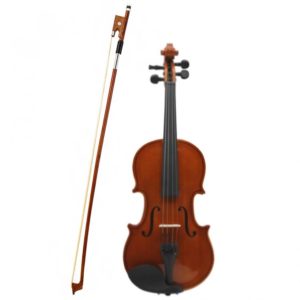
From the elegance of the violin to the warm embrace of the cello, and the soulful beauty of the viola, this article explores the captivating realm of these three-stringed instruments. Welcome to “The Harmonious Trio: Exploring the Breathtaking World of Violin, Viola, and Cello“. Unleashing an unforgettable symphony of sounds, the violin, viola, and cello have captivated audiences for centuries.
As we dive into the fascinating history and evolution of these instruments, we will uncover their distinct personalities and roles within the world of music. Discover the unique characteristics of each instrument as we unravel its construction, range, and playing techniques. Explore cherished masterpieces, timeless concertos, and celebrated virtuosos, all hailing from the embrace of these enchanting stringed instruments.
Whether you’re a seasoned musician or a passionate listener, join us on this melodic journey as we unravel the harmonious mysteries of the violin, viola, and cello. Get ready to be transported to a world of breathtaking symphonies and discover the magic within this harmonious trio.
The History and Evolution of the Violin, Viola, and Cello
The violin, viola, and cello, integral to the symphony orchestra, trace their origins to 16th-century Italy. The earliest known examples appear in Gaudenzio Ferrari’s 1530s paintings, showcasing instruments with three strings. The evolution of these string instruments is deeply intertwined with European history, reflecting a blend of artistic and technological advancements. The violin family’s design was refined by notable luthiers such as the Amati family, Jakob Stainer, and Antonio Stradivari, setting the standard for future craftsmanship.
These instruments have undergone various modifications over the centuries, yet their fundamental design remains a testament to their creators’ ingenuity. The sound post, unique to the violin family, enhances the instrument’s resonance and tonal quality. From the courts of Renaissance Italy to modern concert halls, the violin, viola, and cello have not only provided a rich tapestry of sound but also a historical narrative of cultural exchange and innovation.
The Anatomy of the Violin, Viola, and Cello
The violin, viola, and cello are stringed instruments that have captivated audiences with their melodious sounds for centuries. Each instrument is a marvel of craftsmanship, with a complex anatomy that contributes to its unique tonal qualities.
- The violin, a marvel of musical engineering, has a complex anatomy that contributes to its distinctive sound.
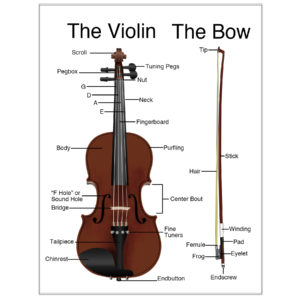
- The body, primarily made of spruce and maple, consists of the top plate or ‘belly’, the backplate, and the sides known as ‘ribs’, which together create the hollow chamber essential for amplification and resonance.
- The scroll, a decorative spiral at the top, leads to the pegbox where the tuning pegs reside, crucial for adjusting the pitch of the strings.
- The neck, typically crafted from maple, supports the fingerboard, often made of ebony, which is vital for note variation and lacks frets, unlike guitars.
- Each component, from the delicate bridge that supports the strings to the tailpiece and fine tuners, plays a role in producing the violin’s warm, rich tones.
Understanding these parts not only aids in maintenance but also enriches the playing experience, allowing musicians to fully express the violin’s potential.
- The viola, a string instrument with a rich history and a tone that is deeper and warmer than the violin, has a
 complex anatomy that contributes to its unique sound.
complex anatomy that contributes to its unique sound. - The scroll, a decorative carving at the top, leads to the pegbox which holds the tuning pegs used to adjust the pitch of the strings.
- The neck of the viola is where the fingerboard is located, a crucial area where the musician’s fingers press down to change notes.
- The body comprises the upper and lower bouts, with the C-bouts connecting them, and houses the soundpost and bass bar, which are essential for transmitting vibrations and enhancing resonance.
- The tailpiece anchors the strings and, along with the bridge, plays a vital role in the sound production of the viola.
- Each part, from the scroll to the tailpiece, is meticulously crafted to create the viola’s distinctive sound, making it an indispensable member of the string family in orchestras and chamber music.
Understanding the anatomy of the viola not only aids players in performing and maintaining their instrument but also enriches the appreciation for the craftsmanship behind its melodious charm.
- The cello, with its rich, resonant tones and elegant form, is a marvel of musical craftsmanship.
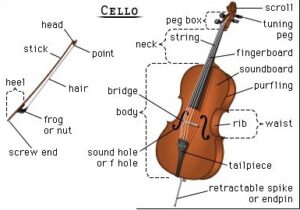
- At the heart of its anatomy lies the body, typically crafted from spruce or maple, which serves as the resonating chamber to amplify the sound produced by the strings.
- The neck, pegbox, and scroll are often carved from a single piece of wood, adding both aesthetic beauty and structural integrity to the instrument.
- The fingerboard, devoid of frets, challenges musicians to find and memorize precise finger positions to elicit the desired notes.
- The bridge and sound holes, or f-holes, are critical in shaping the sound, with the bridge supporting the strings at the necessary height and the f-holes enhancing the top plate’s flexibility and resonance.
- Each component, from the tuning pegs to the tailpiece with fine tuners, is meticulously designed to contribute to the cello’s distinctive sound and playability.
Understanding the anatomy of the cello is not just about recognizing its parts but appreciating the harmony of form and function that makes it a beloved instrument in the world of music.
Differences and Similarities Between the Violin, Viola, and Cello
The violin, viola, and cello are all integral members of the string instrument family, each with a distinct voice and role within an ensemble.
- The violin, known for its bright, high-pitched sound, is often featured as a lead instrument in orchestras and quartets. It has the highest pitch of the three, with strings tuned to G, D, A, and E, and is the smallest in size, allowing for agile and rapid movement across the fingerboard.
- The viola, slightly larger, possesses a deeper, more mellow tone due to its lower tuning of C, G, D, and A, with no E string. Its rich timbre serves as a middle voice, bridging the gap between the violin and cello, often playing counter-melodies or harmonies.
- The cello, with its grand size, commands a powerful presence with a range that extends much lower, tuned to C, G, D, and A, an octave below the viola. Its sonorous and warm tones can evoke a wide range of emotions, from melancholy to exuberance, making it a versatile solo instrument as well as a foundational component of the string section.
Despite these differences, the violin, viola, and cello share many similarities. They are all played with a bow or by plucking the strings, have similar body shapes, and are constructed with the same components such as strings, bridges, fingerboards, scrolls, tuning pegs, and tailpieces.
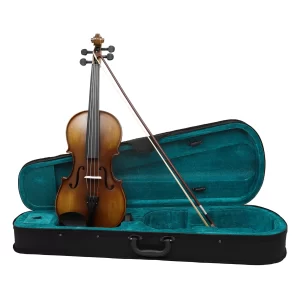
The hollow body of each instrument is crucial for sound resonance, amplifying the vibrations of the strings within the wooden chamber to produce their unique sounds. Additionally, they share some common strings—D, G, and A—which contributes to their ability to blend harmoniously when played together.
Choosing between these instruments often depends on personal preference, physical compatibility, and the desired role within an ensemble. The violin’s agility and high register might appeal to those who enjoy being at the forefront of performances, while the viola’s rich alto voice attracts those who prefer a more nuanced, supporting role. The cello offers a balance between melody and harmony, suitable for those drawn to its deep, resonant tones and the expressive potential it holds.
In terms of playability, each instrument presents its own set of challenges.
- The violin requires precise intonation due to its smaller size and closer string spacing.
- The viola demands a slightly different technique to accommodate its larger size and thicker strings, which require more bow pressure and arm weight.
- The cello, played in a seated position, involves a different posture and bowing angle, with its larger fingerboard necessitating greater finger spacing and reach.
Ultimately, the violin, viola, and cello are all beautiful instruments capable of producing a wide array of musical expressions. Whether a musician chooses the bright, leading tones of the violin, the warm, supporting voice of the viola, or the rich, emotive depth of the cello, each instrument offers a unique pathway to musical exploration and fulfilment.
The decision to play one over the others should be guided by personal affinity, physical comfort, and the joy of creating music that resonates with the player’s artistic sensibilities.
Together, these instruments form a cohesive family, each contributing its voice to the rich tapestry of orchestral and chamber music. Their differences in pitch, size, and timbre are as much a testament to their individuality as their shared characteristics are to their familial bond. In the hands of skilled musicians, the violin, viola, and cello come alive, telling stories through sound and emotion that transcend the boundaries of language and culture.
They are not just instruments, but vessels of human expression, shaped by centuries of craftsmanship and tradition, continuing to evolve and inspire with each note played.
Techniques and Playing Styles for the Violin, Viola, and Cello
The violin, viola, and cello are string instruments that form the core of an orchestra, each with its unique techniques and playing styles.
- The violin is a versatile instrument that accommodates a vast array of playing techniques and styles, each capable of producing unique sounds and expressions. Fundamental to mastering the violin is understanding various bowing techniques, such as détaché, where each note is played with a separate bow stroke, or legato, which creates a smooth, connected sound. Advanced techniques like spiccato, a controlled bouncing of the bow, and col legno, where the wood of the bow is used to strike the strings, add texture and rhythm to the music. Players also employ left-hand techniques like vibrato, to add warmth and emotion, and pizzicato, for plucking the strings. Each style, from classical to folk, jazz to contemporary, utilizes these techniques differently, allowing violinists to explore a wide spectrum of musical landscapes. Mastery of these techniques not only enhances technical proficiency but also enriches artistic expression, enabling violinists to convey complex emotions and narratives through their performances.
- The viola, with its rich and mellow tones, offers a unique range of techniques and playing styles that set it apart from other string instruments. Mastering the viola involves a combination of foundational exercises and advanced studies. Daily practice of scales and arpeggios is crucial, as they are the building blocks of melody and harmony in music. Moreover, understanding the key signatures and the layout of the fingerboard through these exercises can significantly enhance sight-reading skills and overall musicianship.
For those seeking to delve deeper into viola techniques, exploring the works of composers and pedagogues such as Campagnoli, Sevcik, and Kreutzer can be immensely beneficial. These studies focus on developing coordination, strength, and agility in the left hand, which are essential for performing complex pieces with precision. Additionally, the viola’s ability to play chords and double stops requires a disciplined approach to practice, ensuring that each note is clear and in tune.
As for playing styles, violists often employ a weightier bowing technique to bring out the instrument’s sonorous quality. This involves broader strokes and deliberate use of bow speed and pressure to achieve the desired dynamics and articulation. Expressive techniques like legato, staccato, spiccato, and tremolo add colour and texture to the music, allowing the violist to convey a wide range of emotions through their performance. Ultimately, the journey to mastering the viola is one of continuous learning and refinement, where each practice session builds upon the last to create a rich tapestry of sound and expression.
- The cello, with its rich and emotive sound, offers a wide range of techniques and playing styles that can bring music to life. The foundation of cello playing involves mastering the posture and bowing techniques, ensuring the right hand draws the bow across the strings with precision, while the left hand determines the pitch on the fingerboard. Vibrato adds an expressive voice-like quality to the notes, achieved through subtle forearm movements rather than the upper arm, creating a variation in pitch that enhances the musical expression. Advanced techniques include double stops, where two strings are played simultaneously, and pizzicato, where the strings are plucked with fingers, adding a unique texture to the music. Shifting and finger placement are crucial for playing higher notes and require careful practice to maintain intonation. Exploring different genres, from classical to contemporary, allows cellists to develop their unique style, while also understanding the versatility of the cello.
For those looking to delve deeper into cello repertoire, studying the works of renowned composers and practising consistently with focused strategies can lead to significant improvement and a more profound musical experience.
All three instruments utilize vibrato to add expression to notes, and pizzicato, where the strings are plucked with fingers, to create a different texture. Mastery of these instruments involves not only technical proficiency but also a deep understanding of musicality and expression.
To excel, musicians must immerse themselves in a diverse repertoire, from classical to contemporary, and continually refine their technique and interpretative skills. The journey to proficiency is a lifelong pursuit of passion and dedication to the craft of string playing.
Choosing the Right Instrument: Violin, Viola, or Cello
Choosing between the violin, viola, and cello involves understanding the unique characteristics and sounds of each instrument.
- The violin is known for its bright, high-pitched sound and is often featured playing the melody in orchestral pieces. It has the highest pitch of the three, with strings tuned to G, D, A, and E.
- The viola, slightly larger than the violin, offers a deeper, warmer tone with its C, G, D, and A strings, and often plays the harmony.
- The cello, with its rich and resonant tones, plays an octave lower than the viola and is tuned to C, G, D, and A. It can carry the bass line as well as the melody.
When choosing an instrument, consider the physical size, the type of music you are drawn to, and the role you wish to play in an ensemble. Each instrument requires a different technique and posture, so it’s also important to try them out to see which feels most natural.
The Importance of Proper Maintenance and Care for the Violin, Viola, and Cello
Proper maintenance and care are crucial for the longevity and sound quality of string instruments such as the violin, viola, and cello. Ensuring that these instruments are correctly set up, with the right shoulder rest and bow grip, can significantly affect the ease of playing and the quality of sound produced.
Regular cleaning with a soft, dry cloth is essential to remove rosin dust and sweat and prevent damage to the varnish. Strings should be replaced every 3-6 months, depending on usage, to maintain a consistent sound quality. Additionally, the bridge and soundpost should be checked and adjusted by a professional luthier to ensure they are correctly aligned. Controlling humidity levels is also vital; using a humidifier or dehumidifier can protect the instrument from the adverse effects of too-dry or too-moist environments.
Following these guidelines will help keep your string instrument in excellent condition, ensuring a beautiful sound and a rewarding playing experience.
Joining Orchestras and Ensembles with the Violin, Viola, and Cello
Joining an orchestra or ensemble as a violin, viola, or cello player can be a fulfilling and educational experience.
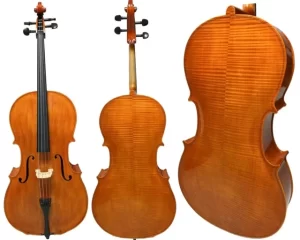
These string instruments form the core of the string section in an orchestra, each contributing its unique sound and range to create a harmonious blend. The violin often carries the melody with its bright and high-pitched tones, while the viola provides rich middle harmonies, and the cello offers a deep, resonant bass.
For those starting out, youth orchestras or training ensembles are excellent for developing ensemble skills, sight-reading, and understanding the nuances of orchestral playing. As musicians progress, they can move up to more advanced groups, where the repertoire expands and the technical demands increase.
Playing in an orchestra not only enhances one’s musicality but also fosters teamwork and a sense of community among musicians.
Conclusion: The Timeless Beauty of the Violin, Viola, and Cello
The violin, viola, and cello, with their rich history and complex craftsmanship, have captivated musicians and audiences for centuries. These string instruments, integral to the orchestra, possess a range of expressions that can evoke the deepest emotions. The violin, with its bright, piercing melodies, contrasts beautifully with the viola’s warm, mellow tones and the cello’s deep, resonant sounds. Together, they create a harmonious blend that can convey the nuances of the human experience.
Their timeless beauty lies not only in the music they produce but also in their ability to connect us to our past and to each other, transcending cultural and temporal boundaries. The mastery required to play these instruments and the dedication of the artisans who craft them ensure that their legacy will continue to inspire generations to come.

